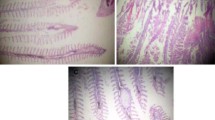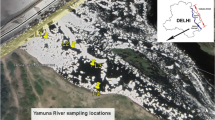Abstract
Sodium dodecyl sulphate (SDS), an anionic surfactant, has been used extensively due to its low cost and excellent foaming properties. Fifteen different bacterial isolates capable of degrading SDS were isolated from detergent contaminated soil by enrichment culture technique and the degradation efficiency was assessed by Methylene Blue Active Substances (MBAS) assay. The most efficient SDS degrading isolate was selected and identified as Pseudomonas aeruginosa S7. The selected isolate was found to harbor a single 6-kb plasmid. Acridine orange, ethidium bromide, SDS and elevated temperatures of incubation failed to cure the plasmid. The cured derivatives of SDS degrading Pseudomonas aeruginosa were obtained only when ethidium bromide and elevated temperature (40°C) were used together. Transformation of E. coli DH5α with plasmid isolated from S7 resulted in subsequent growth of the transformants on minimal salt media with SDS (0.1%) as the sole source of carbon. The SDS degradation ability of S7 and the transformant was found to be similar as assessed by Methylene Blue Active Substance Assay. The antibiotic resistance profiles of S7, competent DH5α and transformant were analyzed and it was noted that the transfer of antibiotic resistance correlated with the transfer of plasmid as well as SDS degrading property.


Similar content being viewed by others

References
Abel PD (1976) Toxic action of several lethal concentrations of an anionic detergent on the gills of the brown trout (Salmo trutta L.). J Fish Biol 9:441–446
Bhadbhade BJ, Dhakephalkar PK, Sarnaik SS, Kanekar PP (2002) Plasmid associated biodegradation of an organophosphorus pesticide, Monocrotophos by Pseudomonas mendocina. Biotechnol Lett 24:647–650
Chakrabarty AM (1972) Genetic basis of the biodegradation of salicylate in Pseudomonas. J Bacteriol 112:815–823
Chakrabarty AM (1976) Plasmids in Pseudomonas. Annu Rev Genet 10:7–30
Deshpande NM, Dhakephalkar PK, Kanekar PP (2001) Plasmid mediated dimethoate degradation in Pseudomonas aeruginosa MCMB–427. Lett Appl Microbiol 35:275–279
Gadler P, Faber K (2007) New enzymes for biotransformations: microbial alkyl sulfatases displaying stereo- and enantioselectivity. Trends Biotechnol 25(2):83–88
Hayashi K (1975) A rapid determination of SDS with methylene blue. Anal Biochem 67:503–506
Kostal J, Suchanek M, Klierova H, Demnerova K, Kralova B, Mcbeth DL (1998) Pseudomonas C 12B, an SDS degrading strain, harbours a plasmid coding for degradation of medium chain length n-alkanes. Int Biodeterior 42:221–228
Kulkarni RS, Kanekar PP (1998) Effects of some curing agents on phenolypic stability in Pseudomonas putida degrading ε- caprolactam. World J Microbiol Biotechnol 14:255–257
Maniatis T, Fritsch EF, Sambrook J (1982) Molecular cloning. A laboratory manual. Cold Spring Harbor Laboratory, Cold spring Harbor, NY, pp 1–545
Marchesi JR, Owely SA, White GF (1994) SDS degrading bacteria attach to riverine sediment in response to the surfactant or its primary biodegradation product dodecan-1-ol. Microbiol 140:2999–3006
Schleheck D, Dong W, Denger K (2000) An Alphaproteobacterium converts linear alkylbenzenesulfonate into sulfophenylcarboxylates and linear alkyldiphenyl etherdisulfonate surfactants into sulfodiphenylethercarboxylates. Appl Environ Microbiol 66:1911–1916
Stephenson JR, Warnes A (1996) Release of genetically modified micro-organisms into the environment. J Chem Tech Biotechnol 65:5–14
Swisher RD (1987) Surfactant biodegradation. In Surfactant Science Series. 18. Marcel Dekker Inc, New York
Trevors JT (1986) Plasmid curing in bacteria. FEMS Microbiol Rev 32:149–157
Wiliams PA (1978) Microbial genetics related to hydrocarbon degradation. In: Watkinso RJ (ed) Development in biodegradation of hydrocarbons. Applied science publishers LTP, London, pp 135–164
Acknowledgments
Authors are grateful to Kerala State Science Technology and environment for financial support.
Author information
Authors and Affiliations
Corresponding author
Rights and permissions
About this article
Cite this article
Yeldho, D., Rebello, S. & Jisha, M.S. Plasmid-Mediated Biodegradation of the Anionic Surfactant Sodium Dodecyl Sulphate, by Pseudomonas aeruginosa S7. Bull Environ Contam Toxicol 86, 110–113 (2011). https://doi.org/10.1007/s00128-010-0162-2
Received:
Accepted:
Published:
Issue Date:
DOI: https://doi.org/10.1007/s00128-010-0162-2



